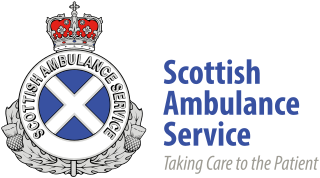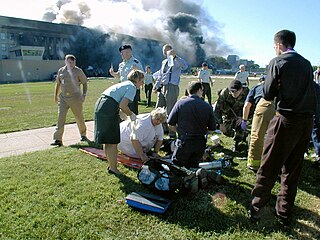Related Research Articles

Safety is the state of being "safe", the condition of being protected from harm or other danger. Safety can also refer to the control of recognized hazards in order to achieve an acceptable level of risk.
In the field of science and engineering, root cause analysis (RCA) is a method of problem solving used for identifying the root causes of faults or problems. It is widely used in IT operations, manufacturing, telecommunications, industrial process control, accident analysis, medicine, healthcare industry, etc. Root cause analysis is a form of inductive and deductive inference.

A nuclear and radiation accident is defined by the International Atomic Energy Agency (IAEA) as "an event that has led to significant consequences to people, the environment or the facility." Examples include lethal effects to individuals, large radioactivity release to the environment, or a reactor core melt. The prime example of a "major nuclear accident" is one in which a reactor core is damaged and significant amounts of radioactive isotopes are released, such as in the Chernobyl disaster in 1986 and Fukushima nuclear disaster in 2011.

The Health Insurance Portability and Accountability Act of 1996 is a United States Act of Congress enacted by the 104th United States Congress and signed into law by President Bill Clinton on August 21, 1996. It aimed to alter the transfer of healthcare information, stipulated the guidelines by which personally identifiable information maintained by the healthcare and healthcare insurance industries should be protected from fraud and theft, and addressed some limitations on healthcare insurance coverage. It generally prohibits healthcare providers and businesses called covered entities from disclosing protected information to anyone other than a patient and the patient's authorized representatives without their consent. The bill does not restrict patients from receiving information about themselves. Furthermore, it does not prohibit patients from voluntarily sharing their health information however they choose, nor does it require confidentiality where a patient discloses medical information to family members, friends or other individuals not employees of a covered entity.

A checklist is a type of job aid used in repetitive tasks to reduce failure by compensating for potential limits of human memory and attention. Checklists are used both to ensure that safety-critical system preparations are carried out completely and in the correct order, and in less critical applications to ensure that no step is left out of a procedure. they help to ensure consistency and completeness in carrying out a task. A basic example is the "to do list". A more advanced checklist would be a schedule, which lays out tasks to be done according to time of day or other factors, or a pre-flight checklist for an airliner, which should ensure a safe take-off.

The terms medical record, health record and medical chart are used somewhat interchangeably to describe the systematic documentation of a single patient's medical history and care across time within one particular health care provider's jurisdiction. A medical record includes a variety of types of "notes" entered over time by healthcare professionals, recording observations and administration of drugs and therapies, orders for the administration of drugs and therapies, test results, X-rays, reports, etc. The maintenance of complete and accurate medical records is a requirement of health care providers and is generally enforced as a licensing or certification prerequisite.
The critical incident technique is a set of procedures used for collecting direct observations of human behavior that have critical significance and meet methodically defined criteria. These observations are then kept track of as incidents, which are then used to solve practical problems and develop broad psychological principles. A critical incident can be described as one that makes a contribution—either positively or negatively—to an activity or phenomenon. Critical incidents can be gathered in various ways, but typically respondents are asked to tell a story about an experience they have had.

The Scottish Ambulance Service is part of NHS Scotland, which serves all of Scotland's population. The Scottish Ambulance Service is governed by a special health board and is funded directly by the Health and Social Care Directorates of the Scottish Government.
Patient safety is a discipline that emphasizes safety in health care through the prevention, reduction, reporting and analysis of error and other types of unnecessary harm that often lead to adverse patient events. The frequency and magnitude of avoidable adverse events, often known as patient safety incidents, experienced by patients was not well known until the 1990s, when multiple countries reported significant numbers of patients harmed and killed by medical errors. Recognizing that healthcare errors impact 1 in every 10 patients around the world, the World Health Organization (WHO) calls patient safety an endemic concern. Indeed, patient safety has emerged as a distinct healthcare discipline supported by an immature yet developing scientific framework. There is a significant transdisciplinary body of theoretical and research literature that informs the science of patient safety with mobile health apps being a growing area of research.
A near miss, near death, near hit, close call is an unplanned event that has the potential to cause, but does not actually result in human injury, environmental or equipment damage, or an interruption to normal operation.
In the field of medicine, a healthcare proxy is a document with which a patient appoints an agent to legally make healthcare decisions on behalf of the patient, when the patient is incapable of making and executing the healthcare decisions stipulated in the proxy. Once the healthcare proxy is effective, the agent continues making healthcare decisions as long as the primary individual is legally competent to decide. Moreover, in legal-administrative functions, the healthcare proxy is a legal instrument akin to a "springing" healthcare power of attorney. The proxy must declare the healthcare agent who will gain durable power attorney. This document also notifies of the authority given from the principal to the agent and states the limitations of this authority.
A never event is the "kind of mistake that should never happen" in the field of medical treatment. According to the Leapfrog Group never events are defined as "adverse events that are serious, largely preventable, and of concern to both the public and health care providers for the purpose of public accountability."

Disaster medicine is the area of medical specialization serving the dual areas of providing health care to disaster survivors and providing medically related disaster preparation, disaster planning, disaster response and disaster recovery leadership throughout the disaster life cycle. Disaster medicine specialists provide insight, guidance and expertise on the principles and practice of medicine both in the disaster impact area and healthcare evacuation receiving facilities to emergency management professionals, hospitals, healthcare facilities, communities and governments. The disaster medicine specialist is the liaison between and partner to the medical contingency planner, the emergency management professional, the incident command system, government and policy makers.
An emergency procedure is a plan of actions to be conducted in a certain order or manner, in response to a specific class of reasonably foreseeable emergency, a situation that poses an immediate risk to health, life, property, or the environment. Where a range of emergencies are reasonably foreseeable, an emergency plan may be drawn up to manage each threat. Most emergencies require urgent intervention to prevent a worsening of the situation, although in some situations, mitigation may not be possible and agencies may only be able to offer palliative care for the aftermath. The emergency plan should allow for these possibilities.

A mass casualty incident describes an incident in which emergency medical services resources, such as personnel and equipment, are overwhelmed by the number and severity of casualties. For example, an incident where a two-person crew is responding to a motor vehicle collision with three severely injured people could be considered a mass casualty incident. The general public more commonly recognizes events such as building collapses, train and bus collisions, plane crashes, earthquakes and other large-scale emergencies as mass casualty incidents. Events such as the Oklahoma City bombing in 1995, the September 11 attacks in 2001, and the Boston Marathon bombing in 2013 are well-publicized examples of mass casualty incidents. The most common types of MCIs are generally caused by terrorism, mass-transportation accidents, fires or natural disasters. A multiple casualty incident is one in which there are multiple casualties. The key difference from a mass casualty incident is that in a multiple casualty incident the resources available are sufficient to manage the needs of the victims. The issue of resource availability is therefore critical to the understanding of these concepts. One crosses over from a multiple to a mass casualty incident when resources are exceeded and the systems are overwhelmed.
A surrogate decision maker, also known as a health care proxy or as agents, is an advocate for incompetent patients. If a patient is unable to make decisions for themselves about personal care, a surrogate agent must make decisions for them. If there is a durable power of attorney for health care, the agent appointed by that document is authorized to make health care decisions within the scope of authority granted by the document. If people have court-appointed guardians with authority to make health care decisions, the guardian is the authorized surrogate.
A director of nursing (DON) is a registered nurse who supervises the care of all the patients at a health care facility. The director of nursing has special training beyond the training of a staff nurse for the position that pertains to health care management, and in some places, a director of nursing must hold a special license in order to be employed in that capacity.
The General Civil Aviation Authority (GCAA) is the civil aviation authority of the United Arab Emirates (UAE). Its head office is in Al Rawdah, Abu Dhabi.
Forensic nursing is the application of the forensic aspects of healthcare combined with the bio/psycho/social/spiritual education of the registered nurse in the scientific investigation and treatment of trauma and/or death of victims and perpetrators of violence, criminal activity, and traumatic accidents In short, forensic nursing is the care of patients intersecting with the legal system.
A significant event audit (SEA), also known as significant event analysis, is a method of formally assessing significant events, particularly in primary care in the UK, with a view to improving patient care and services. To be effective, the SEA frequently seeks contributions from all members of the healthcare team and involves a subsequent discussion to answer why the occurrence happened and what lessons can be learned. Events triggering a SEA can be diverse, include both adverse and critical events, as well as good practice. It is most frequently required for appraisal, revalidation and continuing professional development.